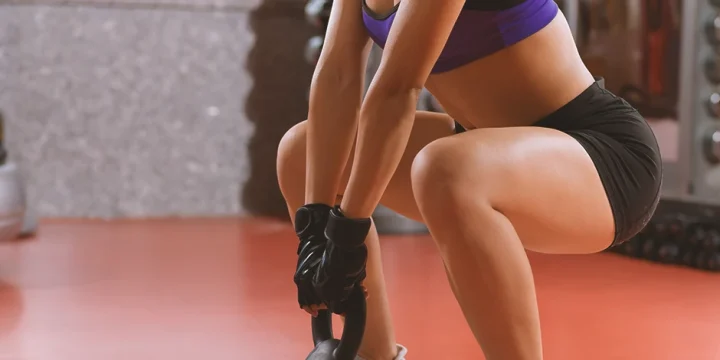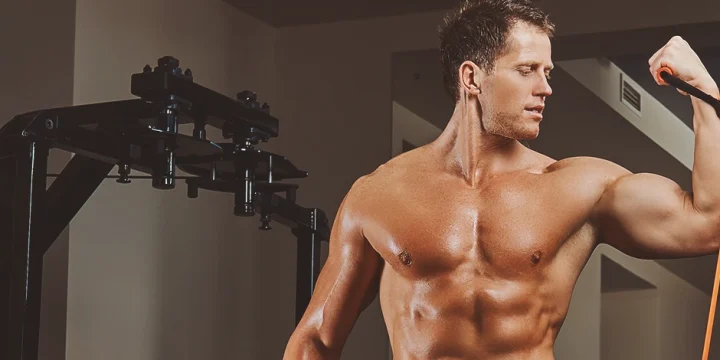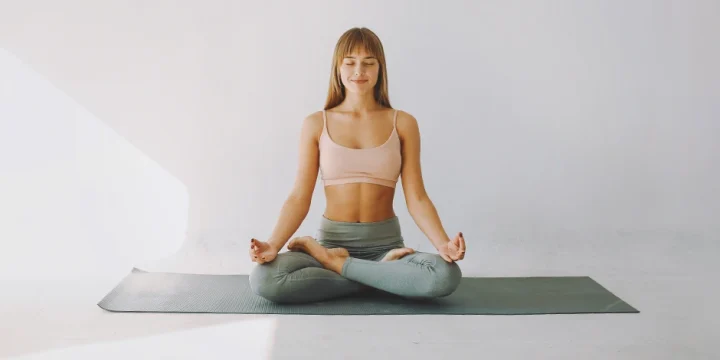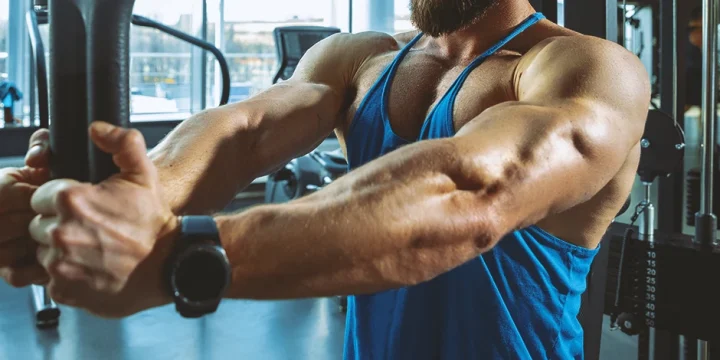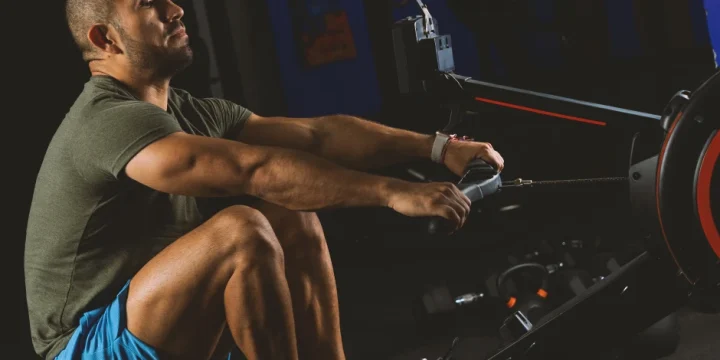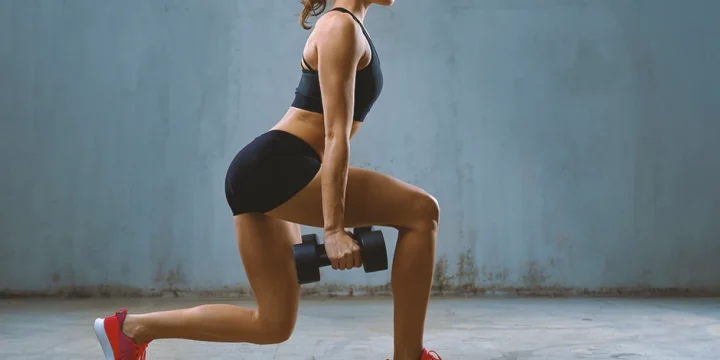A rowing workout is a must in any whole-body exercise plan.
In my experience as a certified fitness trainer, I have found that no matter if my clients want to tone their upper body, build greater strength and endurance, or improve their stability and balance, a rowing workout is always a great option.
For this article, I picked some of my favorite row exercises, and I will teach you how to do them.
Let’s begin.
Quick Summary
- Many row exercise variations use different equipment like a barbell, kettlebell, or resistance bands.
- Rowing exercises in strength training are pulling movements that strengthen the back, shoulders, and arms.
- Row exercises are horizontal pull movements, unlike pull-ups, which are vertical pulls.
Best Rowing Exercises

Rowing exercises are strength-training horizontal pull movements that cause your shoulder blades to retract.
They are different from exercises like pull-ups, which are vertical pull exercises.
Maintain good technique when performing the following exercises, and always use a weight appropriate for your fitness level.
It is advisable to begin with a lighter weight to ensure you do the exercise correctly.
You can add more weight as you master the movement and get stronger.
If you can’t do the suggested number of reps and sets outlined in this article, do as many rounds as possible, ensuring you perform equal reps on each side for one-sided exercises.
TRX Row
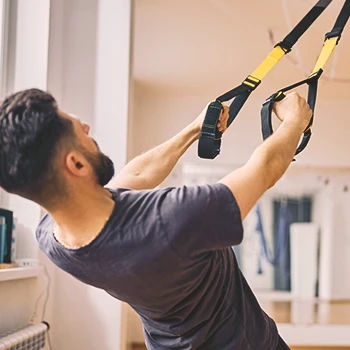
Also known as the suspension row, the TRX row is an effective exercise that can help strengthen your back muscles, build core stability, and improve overall balance.
Here’s how to do it:
- Set up the TRX straps to be mid-length and secured to the anchor point.
- Adjust your height and step away from the anchor point so there is tension in the straps.
- Stand, positioning your feet hip-width apart.
- Hold a strap handle in each hand.
- Walk your feet forward until your body is at a 45-degree angle.
- You’ll be leaning back with your arms straight at this point.
- Keep your core engaged and your shoulders locked, not rolled forward.
- Pull your body toward the anchor until your elbows reach chest height.
- Continue to keep your core engaged so your hips don’t sag.
- Slowly lower back down to the start and repeat.
- Perform 8–12 reps, three sets total.
Related Articles:
Seated Resistance Band Row
You'll build core stability and strengthen your back muscles with the resistance band row, which can change the difficulty of these exercises by changing out the resistance bands.
Here’s how to do it:
- Sit with your legs extending out in front of you and a resistance band looped securely around each of your feet.
- Hold each end firmly in each hand, palms facing down.
- Extend your arms so they are parallel to the floor.
- Slowly and smoothly, pull them both back toward your chest.
- Keep your elbows close to your body.
- Engage your rhomboids at the peak of the movement.
- Return to the start slowly and repeat for 8–12 reps.
- Perform 2–3 sets.
Related: How to Do Resistance Band Rows
Barbell Bent-Over Row

This variation of a barbell row is an effective exercise for developing strength and size in muscles like the latissimus dorsi, rhomboids, and trapezius.
Here’s how to do it:
- Start with your feet shoulder-width apart, holding a barbell with your palms facing down.
- Lean forward at your hips, keeping your back flat, until your torso is parallel to the floor.
- Keep your knees bent slightly so they don’t lock.
- Engage your core and pull the barbell toward your torso, bending at the elbows as you lift.
- Squeeze your shoulder blades at the peak of the movement.
- Lower the weight slowly back down to the starting positions, and repeat.
- Perform three sets of 8–12 reps.
Standing Single-Arm Cable Row
This row variation is a great way to build strength in your back and shoulders using the resistance of a cable machine.
Here’s how to do it:
- Set up the cable machine with a handle at chest height.
- Stand facing the cable machine, holding the handle with one hand with an overhand grip.
- Begin by keeping your back straight and slightly bending your hips.
- Your arm should be straight and perpendicular to your body.
- Keep your elbow close to your side.
- Engage your core as you slowly pull the handle toward your chest.
- When you reach shoulder height, hold briefly before slowly lowering back to the start.
- Repeat for 8–12 reps.
- Switch arms.
- Perform 2–3 sets.
Also Read: 7 Best Cable Machine Bicep Exercises
Inverted Row with Feet Elevated

Inverted rows are an excellent way to work the back muscles.
This variation adds more challenge to your workout by targeting your core and upper body by elevating your feet.
Ensure you do not arch your back or swing when lifting or lowering yourself during this exercise.
Here’s how to do it:
- Begin by lying under a sturdy bar (a Smith machine or power rack works well).
- Place your feet on an elevated surface like a bench or box, pointing your toes toward the ceiling.
- Grip the bar so you hang underneath with your body in a straight line.
- Squeeze your rhomboids as you pull yourself up until your chest reaches the bar.
- Hold for one second.
- Return slowly to the start.
- Repeat 2–3 sets of 8–12 reps.
T-Bar Row
Like the barbell row, the T-bar row is a horizontal pull exercise that targets the upper back, lats, forearms, and biceps.
Here’s how to do it:
- Place one end of an empty barbell in the corner of a room.
- Weight down the end in the corner with dumbbells or weight plates.
- Load weight plates on the opposite end of the bar.
- Straddle the bar and lean forward until your torso is at a 45-degree angle to the floor.
- Hook a V-grip handle under the bar and hold it with both hands, fully extending your arms.
- Keeping your lower back in a neutral position, pull your shoulders back.
- Pull the bar until the weight plates touch your chest.
“To yield the best results, start slow and focus on your form first. As you progress, slowly add more weight or resistance or increase your reps and sets.”
- Katey Davidson, MScFN, CPT
Single-Arm Dumbbell Bent-Over Row

A great variation of the classic dumbbell row, this exercise targets your upper back and core muscles.
Here’s how to do it:
- Stand with your feet shoulder-width apart.
- Point your toes forward.
- Hold a dumbbell with a neutral grip close to your body in one hand with your arm extended.
- Bend forward slightly from the hips and make sure your back is flat.
- Pull the dumbbell toward your chest.
- Pause for two seconds before lowering back down under control to return to the start.
- Perform 8–12 reps before switching sides.
- Aim for 2–3 sets.
Seated Cable Row
Ensure proper form and breathing when performing seated cable rows to avoid injury. Keep the lower back slightly arched to prevent overextension of the spine.
Here’s how to do it:
- Sit on a bench at a lat pulldown station.
- Place your feet firmly on the platform in front of you.
- Grasp the cable attachment with both hands using an overhand grip and just wider than shoulder width.
- Pull the weight toward your torso while keeping your elbows close to your body.
- Keep your core tight throughout the entire range of motion.
- Squeeze the rhomboids at the peak of the movement.
- Return to the starting position.
- Repeat for 8–12 reps.
- Perform 2–3 sets.
Kettlebell Row

Like a dumbbell row, kettlebell rows are a great exercise to build strength and definition in the upper back, shoulders, biceps, and core.
Maintaining good form and using a kettlebell that is the appropriate weight for your strength level will ensure optimal results.
Here’s how to do it:
- Stand with your feet hip-width apart.
- Bend your hips so that your torso is parallel to the floor.
- Hold a kettlebell in one hand.
- Keep your core engaged and lift the kettlebell toward your torso, keeping it close to your body.
- Don’t flare your elbows outward.
- Keep your movement slow and controlled.
- Reverse the motion, fully extending your arm again.
- Repeat for 8–12 reps.
- Switch hands and perform the same number of reps.
- Aim to do three sets.
How Strength Training Can Help Your Rowing Workout

Many clients come to me looking for training tips for using rowing machines.
The benefits of rowing for both the upper and lower body include improved cardiovascular endurance and fat loss [1].
Strength training, like the above-mentioned exercises, can enhance your rowing machine workout and other cardio exercises like running, cycling, and swimming.
These exercises can:
- Improve your muscle strength and power
- Increase your endurance
- Reduce your injury risk
- Boost your rowing performance, helping you burn more calories
Also Read: Best Rowing Machines For Home Gym
FAQs
What Is the Most Effective Back Row?
The most effective row is the bent-over row because it works several joints and muscles. You can do a bent-over row using weights like barbells, dumbbells, or kettlebells to gain strength in the back, glutes, hamstrings, shoulders, and arms.
Do Rows Build Mass?
Yes, rows build mass. Strength training rowing workouts build muscle mass in the glutes, hamstrings, shoulders, lats, biceps, triceps, and upper and lower back.
Row Your Way to a Strong Back
Exercises like bent-over rows and seated rows help build strength, balance, and overall fitness. Like with any workout routine, for best results, stay hydrated and fuel your body with a healthy diet.
I also encourage my clients to drink a post-workout protein shake to promote muscle repair. We have extensively tested the following protein powders:
Check out the lists for our “Editor’s Pick” protein powder to help repair and build your muscles after your next row workout.
References:
- https://www.nytimes.com/2023/01/03/well/move/strength-training-cardio-exercise.html
About The Author
You May Also Like
